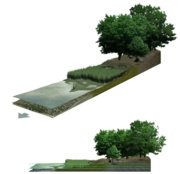User:Patronus19/Tidal marsh
| This is the sandbox page where you will draft your initial Wikipedia contribution.
If you're starting a new article, you can develop it here until it's ready to go live. If you're working on improvements to an existing article, copy only one section at a time of the article to this sandbox to work on, and be sure to use an edit summary linking to the article you copied from. Do not copy over the entire article. You can find additional instructions here. Remember to save your work regularly using the "Publish page" button. (It just means 'save'; it will still be in the sandbox.) You can add bold formatting to your additions to differentiate them from existing content. |
Intro, 3rd paragraph:[edit]
The state of tidal marshes can be dependent on both natural and anthropogenic processes[1]. In recent periods, human practices, small and large scale, have caused changes in ecosystems that have had a significant impact on the preservation of tidal marsh ecosystems[1]. Some smaller scale changes include headward (i.e. upstream) erosion[2] and coastal development. Large system changes include pollution and sea level rise (from climate change). These changes are all putting pressure on tidal marshes.
Types[edit]
Tidal marshes can be found in two main places: coasts and estuaries. Coastal tidal marshes lie along coasts and estuarine tidal marshes lie inland within the tidal zone[3]. Coastal tidal marshes are found within coastal watersheds and encompass a variety of types including fresh and salt marshes, bottomland hardwood swamps, mangrove swamps, and palustrine wetlands. Estuarine tidal marshes are found in estuaries, areas where freshwater streams flow into brackish areas.
They can be categorized based on salinity level, elevation, and sea level 1,7 in original article. Tidal marshes are commonly zoned into lower marshes (also called intertidal marshes) and upper/ high marshes, based on their elevation above sea level[4]. A middle marsh zone also exists for freshwater tidal marshes. Location determines the controlling processes, age, disturbance regime, and future persistence of tidal marshes. Tidal marshes are differentiated into freshwater, brackish, and salt according to the salinity of their water 1 in original article[4][3].
Freshwater[edit]
Freshwater tidal marshes live more inland than saltwater marshes, but their proximity to the coast still allows for daily fluctuations from tides[5]. The inland location allows for a majority of the water content to be from freshwater stream discharge, meaning the salt content is low[5].
Tidal freshwater marshes are further divided into deltaic and fringing types (4 in original article).
Extensive research has been conducted on deltaic tidal freshwater marshes in the Chesapeake Bay 5 in original article, which were formed as a result of historic deforestation and intensive agriculture6 in original article.
Freshwater tidal marshes are highly productive and are home to a variety of organisms. There is a variety of vegetation that can reside in freshwater marshes. There is also a vast amount of insects which attract birds, such as wrens and warrens. Aquatic birds, such as ducks and herons, also live in these marshes. Freshwater tidal marshes also serve as spawning grounds for anadromous fish, such as shad and herring. These fish spend most of their lives in saltwater areas, but return back to freshwater during reproduction.
Tidal freshwater marshes are also highly productive, generate a large amount of good quality biomass[3]. They also serve as good waste treatment areas, based on denitrification potential[3].
Saltwater[edit]
Saltwater tidal marshes live on coastlines in areas that are not completely exposed to the open ocean. The volume of water is dependent on the tides. Plant variation throughout marshes can be due to differences in tide exposure and frequency[4].
Some different types include bottomland hardwood swamps, mangrove swamps, and palustrine wetlands9 in original.
Saltwater tidal marshes are correlated with higher decomposition rates and lower denitrification rates[3].
Island and Barrier Island[edit]
Tidal Marshes also form between a main shoreline and barrier islands. These elongated shifting landforms evolve parallel and in close proximity to the shoreline of a tidal marsh10 in original. Many become fully submerged at high tide, and become directly attached to the mainland when at low tide. Barrier island formation includes mechanisms such as offshore bar theory, spit accretion theory, and climate change11,12 in original.
Gallery[edit]
- Salt marshes during different tides. From the original tidal diagrams of a salt marsh from the NOAA, edited to remove all text.
-
At high tide.
-
At mean tide.
-
At low tide.
-
At spring high tide.
References[edit]
- ^ a b "ShieldSquare Captcha". hcvalidate.perfdrive.com. doi:10.1088/1748-9326/ab5a94/meta. Retrieved 2023-04-11.
- ^ Schile, Lisa M.; Callaway, John C.; Morris, James T.; Stralberg, Diana; Parker, V. Thomas; Kelly, Maggi (2014). "Modeling tidal marsh distribution with sea-level rise: evaluating the role of vegetation, sediment, and upland habitat in marsh resiliency". PloS One. 9 (2): e88760. doi:10.1371/journal.pone.0088760. ISSN 1932-6203. PMC 3923833. PMID 24551156.
{{cite journal}}: CS1 maint: unflagged free DOI (link) - ^ a b c d e Craft, Christopher; Clough, Jonathan; Ehman, Jeff; Joye, Samantha; Park, Richard; Pennings, Steve; Guo, Hongyu; Machmuller, Megan (2009-03). "Forecasting the effects of accelerated sea-level rise on tidal marsh ecosystem services". Frontiers in Ecology and the Environment. 7 (2): 73–78. doi:10.1890/070219. ISSN 1540-9295.
{{cite journal}}: Check date values in:|date=(help) - ^ a b c Anderson, Carlton P.; Carter, Gregory A.; Waldron, Margaret C. B. (2022-10-03). "Precise Elevation Thresholds Associated with Salt Marsh–Upland Ecotones along the Mississippi Gulf Coast". Annals of the American Association of Geographers. 112 (7): 1850–1865. doi:10.1080/24694452.2022.2047593. ISSN 2469-4452.
- ^ a b "Marsh". education.nationalgeographic.org. Retrieved 2023-04-11.




